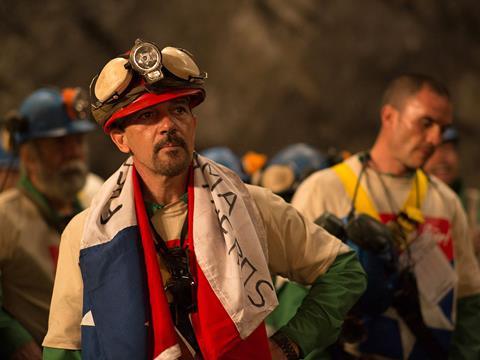Dir Patricia Riggen. US. 2015. 127mins

The 2010 Chilean disaster, which left thirty-three miners trapped underground for sixty-nine days in the San Jose gold mine in the Atacama desert, is the basis for this stirring but highly conventional picture.
Some of the tears that will be shed in this film will be honestly earned
The combination of human interest and a sprinkling of star power – Antonio Banderas plays ‘Super Mario’, the unofficial leader of the trapped diggers; Juliette Binoche is unlikely casting as a feisty empanada saleswoman – should generate interest in this feel-good tale of survival against the odds. However the claustrophobic prospect of spending over two hours 2,300 feet underground with a bunch of sweaty men might make this a tough marketing prospect.
Mexican born director Patricia Riggen uses the brief period of calm before disaster strikes the community to establish thumbnail sketches of the miners and, to a lesser extent, their loved ones. With his soccer-star daughter and beautiful wife, Mario (Banderas) is the cheerful miner. There is also the miner about to retire, the alcoholic miner, the philandering miner, the soon-to-be-a-dad miner, the Bolivian miner and the Elvis impersonator miner.
It’s fair to say that, in most cases, we don’t get much beyond these first impressions. While the size of the cast obviously precludes in-depth character development for everyone, it seems a bit of a wasted opportunity that the screenplay continually reiterates what we already know about each of the key characters, rather than showing us something that is new.
The strongest personality to emerge from the extended families is Maria (Binoche), the itinerant pastry hawker and estranged sister of troubled alcoholic Dario (Juan Pablo Raba). Outspoken and given to wearing strident green eyeshadow to demonstrate her independent personality, Maria is instrumental in rallying the other family members into a permanent vigil at the locked gates of the mine. Given the apparent indifference of the mining company, this continual reminder that the people of Copiapo are not going to give up on their men proves crucial.
The collapse itself, although a relatively brief element in the film, is well handled. A torrent of boulders rushes through the mine, tossing aside a JCB digger like a child’s toy. The men, loaded onto two underground vehicles, flee towards the relative safety of ‘the refuge’, an underground cavern which is supposed to be equipped with food and medical supplies. In reality, as with so many health and safety elements in the mine – including the escape ladders – the owners have skimped on their commitments.
Below ground, with no way of knowing whether rescue is coming, the miners subsist on miniscule rations – a teaspoon of tinned tuna a day, mixed into filtered water. The production design is solid, although it doesn’t quite catch the foetid misery of thirty-three man crammed together in a sweltering, stale cavern. Above ground, the government, represented by idealistic new minister for mining Laurence Golborne (Robrigo Santoro), is trying to manage the situation, as the world’s media takes interest. Gabriel Byrne plays the expert in mining disasters who is flown in to explain the impossibly small chance of a successful rescue to the rest of the cast.
Accompanied by a score which goes big on South American flutes and guitars, photogenic peasants hold candles aloft. There are lots of man-hugs and macho tears. It’s as though Riggen directs from a checklist of proven emotive shots. However there is no question that this is an extraordinary tale of human fortitude and resilience: at least some of the tears that will be shed in the film will be honestly earned.
Production company: Phoenix Pictures
Contact: Alcon Entertainment, www.alconent.com
Producers: Mike Medavoy, Robert Katz, Edward McGurn
Screenplay: Mikko Alanne, Craig Borten, Michael Thomas
Cinematography: Checco Varese
Editor: Michael Tronick
Production design: Marco Niro
Main cast: Antonio Banderas, Juliette Binoche, Gabriel Byrne, Lou Diamond Phillips, Rodrigo Santoro
























